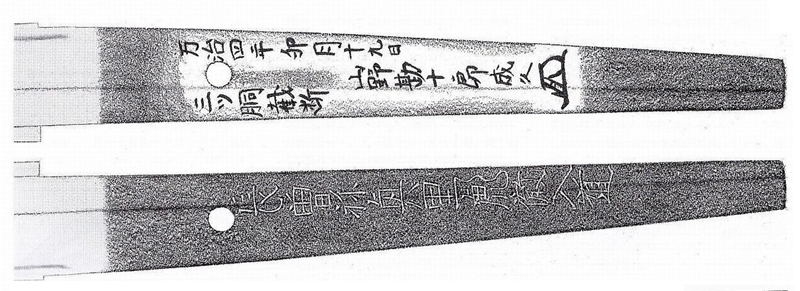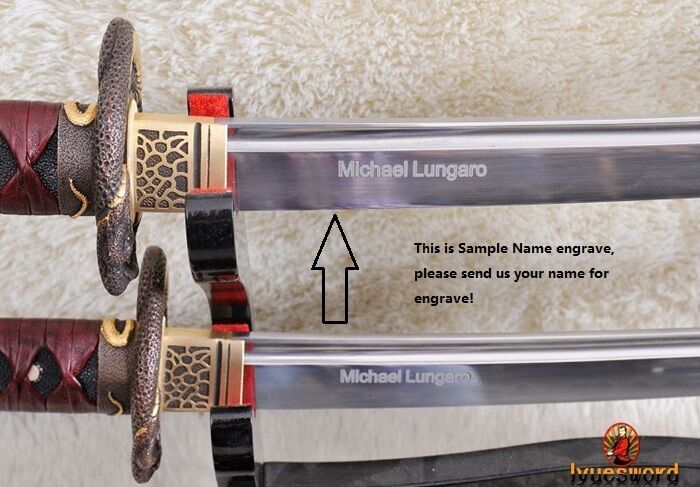By lyuesword | 18 December 2020 | 1 Comments
The Art of Engraving on Swords
----------
His heart was pounding. His hands were shaking. It was finally his. After years of admiring his grandfather's sword, handed down through generations, he was now holding it in his hands. The night before, his grandfather -- and hero he had always looked up to -- had described the family importance of the katana, and how it had been handed down from his own grandfather to grandson in the past.
His grandfather had also shown him how to take the sword apart, to keep it in its best condition. Slowly, he pulled the blade from within the scabbard, and then, even more slowly and using the tools his grandfather had specified, gently separated the hilt from the handle.
He saw something he hadn't expected: characters engraved on the tang.
The sword's tang was engraved. What was this? And what did it all mean? Who might have added this to the sword? He planned to ask his grandfather that same evening.
And so began his curiosity into the engravings and markings of katana....
----------
Were Japanese Katanas Engraved In The Past?
Dating back to the first records we have of Japanese Katana, Wakizashi, Tachi, and other styles of swords, at first engravings were not used often. In the beginning, sword smiths focused on form, function, weight and strength, refining blade types and fittings over time.
As swords and smithing became more advanced, demand grew, as did the skill of the smiths. Ornaments, fittings and engraving started to become more ornate, intricate, and meaningful over time. Smiths also began to attribute their work by way of engraving.
What Were The First Engravings On Katanas?
Traditionally, Japanese Katana were often engraved with three things:
1. The province where the sword was created (two characters);
2. The smith who created it (next two characters);
3. Sometimes, the date and/or an honorific such as 'respectfully'.
Whether or not the date and an honorific was included, depended largely on the period and the emperor during the time the sword was made, as traditions and methods varied depending on the period.
In some cases, lesser-known smiths would falsely inscribe the name of a more famous smith, in order to increase their sales.

Engravings were often inscribed into the tang of the sword, so it was hidden underneath the handle (tsuka). As time went on, sometimes the engravings were in more visible places such as the blade, which is more common now as most sword owners won't take the sword apart, and many use them for display purposes.
More Advanced Engravings: "Horimono" - Gods, Dragons and Other Beings
As time went on, through the Edo period in particular, ornamentation improved further. Beautiful and usually simple engravings called 'horimono' were often added to swords, either for religious reasons or for pure aesthetics.
Historically, these engravings included gods, dragons and other mystical beings, as well as nature-related engravings such as flowers and animals.
Modern Day Interest In Engraving
Engraving of Katanas and other swords today is widespread, with many modern methods available and truly stunning designs created. Movies, anime and fantasy have also created a renewed interest in sword art (in particular, movies such as the Kill Bill series).

Engraving Today: Can I Engrave My Own Sword?
Today, with modern sword smithing methods, many parts of the sword can be customised with marking and engraving, to make it TRULY suit the taste of the owner. We often customise swords for customers, including the handle, the hilt, scabbard, and most commonly, on the blade. Many customers engrave a special message, their own name, or the name of a loved one or friend for whom the sword is a gift.
In particular, our swords are often customised by customers to create something truly unique and special, either for themselves or as a gift for a loved one.

Want a unique sword? Feel free to contact us:
Email: lyuesword@hotmail.com
Website: www.lyuesword.com
Custom Sword Page: www.lyuesword.com/Custom-Sword/customization-options/Create-Your-Own-Swords
His heart was pounding. His hands were shaking. It was finally his. After years of admiring his grandfather's sword, handed down through generations, he was now holding it in his hands. The night before, his grandfather -- and hero he had always looked up to -- had described the family importance of the katana, and how it had been handed down from his own grandfather to grandson in the past.
His grandfather had also shown him how to take the sword apart, to keep it in its best condition. Slowly, he pulled the blade from within the scabbard, and then, even more slowly and using the tools his grandfather had specified, gently separated the hilt from the handle.
He saw something he hadn't expected: characters engraved on the tang.
The sword's tang was engraved. What was this? And what did it all mean? Who might have added this to the sword? He planned to ask his grandfather that same evening.
And so began his curiosity into the engravings and markings of katana....
----------
Were Japanese Katanas Engraved In The Past?
Dating back to the first records we have of Japanese Katana, Wakizashi, Tachi, and other styles of swords, at first engravings were not used often. In the beginning, sword smiths focused on form, function, weight and strength, refining blade types and fittings over time.
As swords and smithing became more advanced, demand grew, as did the skill of the smiths. Ornaments, fittings and engraving started to become more ornate, intricate, and meaningful over time. Smiths also began to attribute their work by way of engraving.
What Were The First Engravings On Katanas?
Traditionally, Japanese Katana were often engraved with three things:
1. The province where the sword was created (two characters);
2. The smith who created it (next two characters);
3. Sometimes, the date and/or an honorific such as 'respectfully'.
Whether or not the date and an honorific was included, depended largely on the period and the emperor during the time the sword was made, as traditions and methods varied depending on the period.
In some cases, lesser-known smiths would falsely inscribe the name of a more famous smith, in order to increase their sales.

Engravings were often inscribed into the tang of the sword, so it was hidden underneath the handle (tsuka). As time went on, sometimes the engravings were in more visible places such as the blade, which is more common now as most sword owners won't take the sword apart, and many use them for display purposes.
More Advanced Engravings: "Horimono" - Gods, Dragons and Other Beings
As time went on, through the Edo period in particular, ornamentation improved further. Beautiful and usually simple engravings called 'horimono' were often added to swords, either for religious reasons or for pure aesthetics.
Historically, these engravings included gods, dragons and other mystical beings, as well as nature-related engravings such as flowers and animals.
Modern Day Interest In Engraving
Engraving of Katanas and other swords today is widespread, with many modern methods available and truly stunning designs created. Movies, anime and fantasy have also created a renewed interest in sword art (in particular, movies such as the Kill Bill series).

Engraving Today: Can I Engrave My Own Sword?
Today, with modern sword smithing methods, many parts of the sword can be customised with marking and engraving, to make it TRULY suit the taste of the owner. We often customise swords for customers, including the handle, the hilt, scabbard, and most commonly, on the blade. Many customers engrave a special message, their own name, or the name of a loved one or friend for whom the sword is a gift.
In particular, our swords are often customised by customers to create something truly unique and special, either for themselves or as a gift for a loved one.

Want a unique sword? Feel free to contact us:
Email: lyuesword@hotmail.com
Website: www.lyuesword.com
Custom Sword Page: www.lyuesword.com/Custom-Sword/customization-options/Create-Your-Own-Swords
Recently Reviews
Read MoreLeave a Reply
Your email address will not be published.Required fields are marked. *